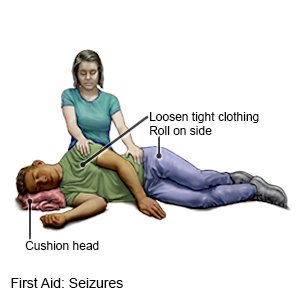Ambulatory Electroencephalogram
Medically reviewed by Drugs.com. Last updated on Apr 6, 2025.
What do I need to know about an ambulatory electroencephalogram (EEG)?
- An ambulatory EEG is a test that measures the electrical activity in your brain. The test may last 24 hours or more. The test will start in your healthcare provider's office and continue in your home. The discs and wires on your head will be connected to a recorder. The recorder is a small box that can be worn on your shoulder or across your waist. Your head may be wrapped with gauze or covered with a cap. The gauze or cap will help hold the discs and wires in place.
- You may need an ambulatory EEG to diagnose or monitor seizures or sleep disorders. An ambulatory EEG can help healthcare providers decide if treatment should be started, stopped, or changed. You may also need an ambulatory EEG before surgery for epilepsy. This will help your surgeon plan your surgery.
What do I need to do during an ambulatory EEG?
- Follow your normal routine as much as possible. Do not remove the gauze or cap or pull on the wires. Do not scratch your head. Do not play contact sports or do activities that could cause the discs to fall off.
- Keep a journal of your symptoms and activity during your EEG. This will help your healthcare provider compare the EEG recording to your symptoms or seizure activity. Ask a family member or caregiver to help you do the following:
- Write down your daily activities such as eating, or sleeping. Your healthcare provider may tell you to write down other activities such as watching TV.
- Write down your symptoms such as a headache, dizziness, or changes in your vision. Write down any other symptoms that your healthcare provider tells you to.
- Write down the details of your seizure. Tell your family or caregiver to press the event button on the recorder if you have a seizure. They should also write down the following information:
- The date and time of your seizure
- How long your seizure lasted
- Body movements and how you act during the seizure
- What you were doing before your seizure started
- How you felt before and after the seizure
- Do not get the EEG recorder wet. Do not shower or go swimming during your EEG. Water can damage the recorder. It is okay to take a sponge bath.
How can others keep me safe during a seizure?
Give the following instructions to family, friends, and coworkers:
- Do not panic.
- Gently guide me to the floor or a soft surface.
- Do not hold me down or put anything in my mouth.
- Place me on my side to help prevent me from swallowing saliva or vomit.

- Protect me from injury. Remove sharp or hard objects from the area surrounding me, or cushion my head.
- Loosen my clothing around the head and neck.
- Time how long my seizure lasts. Call 911 if my seizure lasts longer than 5 minutes or if I have a second seizure.
- Stay with me until my seizure ends. Let me rest until I am fully awake.
- Perform CPR if I stop breathing or you cannot feel my pulse.
- Do not give me anything to eat or drink until I am fully awake.
Drugs used to treat this and similar conditions
Keppra
Keppra is an anti-epileptic drug used to treat partial onset seizures in people with epilepsy ...
Onfi
Onfi (clobazam) is used to treat seizures associated with Lennox-Gastaut syndrome, a form of ...
Ozempic
Learn about Ozempic (semaglutide) for type 2 diabetes treatment, weight management, cardiovascular ...
Banzel
Banzel (rufinamide) is used in combination with other medications to treat adults and children with ...
Ambien
Ambien (zolpidem) is a prescription sedative used to treat insomnia, helping you fall asleep and ...
Epidiolex
Epidiolex (cannabidiol) is an oral prescription liquid CBD medicine that may be used to treat ...
5-hydroxytryptophan/melatonin/pyridoxine
5-hydroxytryptophan/melatonin/pyridoxine systemic is used for sleep disorders
Zolpidem
Zolpidem is a sedative-hypnotic medicine used for the short-term treatment of insomnia (trouble ...
Levetiracetam
Levetiracetam systemic is used for bipolar disorder, epilepsy, hyperekplexia, neuralgia, new daily ...
Call 911 or have someone else call for any of the following:
- Your seizure lasts longer than 5 minutes.
- You have trouble breathing or stop breathing.
- You cannot be woken after your seizure.
- You have more than 1 seizure before you are fully awake or aware.
- You have a seizure in water.
When should I seek immediate care?
- You have more than 1 seizure in 24 hours.
- You are injured during a seizure.
When should I contact my healthcare provider?
- Your discs fall off or your recorder gets wet.
- You have questions or concerns about your condition or care.
Care Agreement
You have the right to help plan your care. Learn about your health condition and how it may be treated. Discuss treatment options with your healthcare providers to decide what care you want to receive. You always have the right to refuse treatment. The above information is an educational aid only. It is not intended as medical advice for individual conditions or treatments. Talk to your doctor, nurse or pharmacist before following any medical regimen to see if it is safe and effective for you.© Copyright Merative 2025 Information is for End User's use only and may not be sold, redistributed or otherwise used for commercial purposes.
Learn more about Ambulatory Electroencephalogram
Care guides
Further information
Always consult your healthcare provider to ensure the information displayed on this page applies to your personal circumstances.
